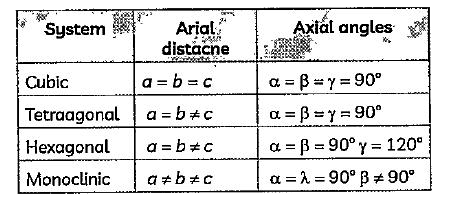Read the passage and answer the following questions.
Crystalline substances can be described by the types of particles in them and the types of chemical bonding that takes place between the particles. There are four types of crystals: (1) ionic, (2)metallic , (3) covalent network, and (4) molecular. 1. Ionic crystals - The ionic crystal structure consists of alternating positively-charged cations and negativelycharged anions. Metallic crystals consist of metal cations surrounded by a "sea" of mobile valence electrons. These electrons, also referred to as delocalized electrons.A covalent network crystal consists of atoms at the lattice points of the crystal, with each atom being covalently bonded to its nearest neighbor atoms .Molecular crystals typically consist of molecules at the lattice points of the crystal, held together by relatively weak intermolecular forces.
The table given below gives the axial distances and axial angles of crystal habits.

How many units cells are present in a cubic shaped ideal crystal of NaCl of mass 1.0 g?
5.14×1021
2.57×1021
1.28×1021
1.71×1021
The correct Answer is:B
No.of unit cells =N0 X mass susbtance Molecular mass XZ=6.022×1023 mol−1×1.0gm58.5gmmol−1×4
Molecular mass of NaCl
=23+35.5
=58.5 gm/mol
=2.57×1021
(For cubic system z =4 )
Related Playlists
Similar Questions
What are ionic crystals ? Discuss the crystal structure of sodium chloride.
View SolutionExamine the given defected crystal

Answer the following questions:
What type of ionic substance show such defect?View SolutionTe defect that is more likely to occur in almost all types of ionic crystals is
View SolutionThe defect that is more likely to occur in almost all types of ionic crystals is
View SolutionGraphite in an example of-
(A) Ionic solid
(B) Covalent Solid
(C) Vander waal’s Crystal
(D) Metallic crystalView SolutionState the main characteristics of an ionic and a network type of crystal citing a suitable example for each.
View SolutionWhat do you understand by imperfections in ionic crystals? Name the types of imperfections which generally occur in ionic crystals.
View SolutionWhat do you understand by imperfections in ionic crystals? Name the types of imperfections which generally occur in ionic crystals
View SolutionStatement -1 : Covalent crystals have the highest melting point .
Statement 2: Covalent bonds are stronge than ionic bonds.View SolutionIn crystals of which one of the following ionic compounds would you expect maximum distance between centres of cations and anions?
View Solution

